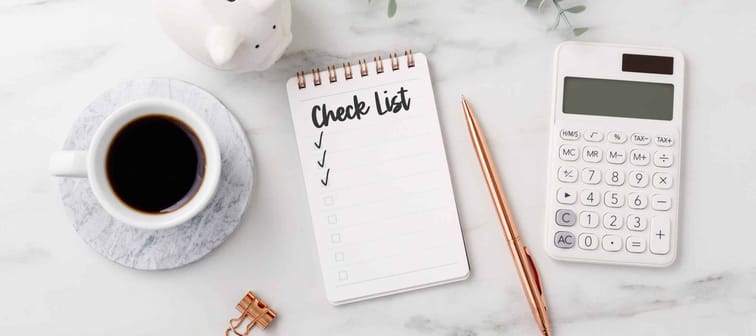The short version
- With an uncertain 2024 ahead, there’s never been a better time for an end-of-year financial health checkup
- Simple exercises like auditing your spending, consolidating your debts, analyzing your credit report, getting fresh quotes on insurance, and reassessing which credit cards are in your wallet can save you massive time, money, and stress
- It also pays to spend a few minutes having a “checkup” with everyone who has a fiduciary duty to you – your CPA, CEPA, CFP, etc.
Kiss Your Credit Card Debt Goodbye
Having a single loan to pay off makes it easier to manage your payments, and you can often get a better interest rate than what you might be paying on credit cards and car loans.
Fiona is an online marketplace offering personalized loan options based on your unique financial situation.
When you consolidate your debt with a personal loan, you can roll your payments into one monthly installment. Find a lower interest rate and pay down your debt faster today.
Get Started1. Audit your bank accounts and reset your budget
One of the first questions to ask yourself before 2023 rolls to a close is:
“Where’d all my money go?”
Not in a sense of how am I this broke? — although, nobody's judging here if that's you — but rather, Where can I be spending less?
When you’re in the weeds of your day to day, it can be hard take a birds' eye view of what’s slowly draining your finances.
For example, in 2019 I bought an old Miata for $1,000. I knew I got the deal of the century. But in the past three years, the car has needed $5,000+ in repairs and maintenance. The bills seemed cheap individually ($260 for insurance, $900 for new suspension, etc.) but they rapidly added up.
In the end I decided to keep the car, but it still helped to answer the question of Why didn’t I take home as much as I thought I would?
While auditing your bank accounts, you may also find other sneaky money grubbers like:
- Subscriptions you’re not using anymore
- Overpriced insurance premiums
- Missing invoices from clients
- Suspicious charges
- Fees that your bank could reverse with a phone call
- In the case of joint finances, possible overspending by your partner
Doing this exercise will also help you reset your budget and perhaps place a cap on certain things, such as takeout, travel, and more.
More: Best money managment apps
2. Check your credit
While you should always be checking your credit at least monthly — and definitely before any loan applications — the end of the year is the ideal time for a deep dive.
Head to a reputable credit score site and spend a few minutes dissecting your credit report. Are there any gremlins in there that need addressing? Do you need some time to repair your credit before applying for that big loan in 2024? Or is everything spick and span?
In my case, I noticed one fuzzy little gremlin hiding in my credit mix. It was an ancient AMEX I didn’t recognize — a sock drawer card the family shared in high school. Thankfully there were no missed payments on it, so I decided to keep my name on it since it was improving my credit history.
Benign or otherwise, you’ll want to catch those gremlins sooner than later — and address known pain points — so you can improve your credit and save on every loan you take out in 2024.
More: How to improve your credit score in one month
Stop overpaying for home insurance
Home insurance is an essential expense – one that can often be pricey. You can lower your monthly recurring expenses by finding a more economical alternative for home insurance.
SmartFinancial can help you do just that. SmartFinancial’s online marketplace of vetted home insurance providers allows you to quickly shop around for rates from the country’s top insurance companies, and ensure you’re paying the lowest price possible for your home insurance.
Explore better rates3. Estimate your 2023 taxes
Knowledge is power, and knowing what your 2023 taxes will look like well before April 15th can be pretty powerful.
Case in point, the number I had rattling around in my head was actually way off from reality. I’d forgotten about some write-offs, so when I plugged my numbers into Intuit’s handy tax estimator tool, I realized I had far overestimated what I’d likely end up owing overall.
This changed how I planned my end of year finances. Instead of hunkering down and staying liquid, I stashed a little extra into Treasury I Savings Bonds.
It’s always helpful to eliminate any surprises well before April 15th.
4. Get new quotes on auto insurance
This may sound out of place (and oddly specific) for an end of year financial checklist, but trust me: it could easily save you hundreds of bucks.
That’s because every auto insurance provider sees each driver/car/address combo totally different. Recently, my quoted rates to insure my Miata for six months were:
- $1,087
- $467
- $1,113
- $867
- $259
Had I stopped on provider #1, I would’ve paid ~$1,500 too much for the same coverage.
If you haven’t shopped around for better rates in a few years, spend 30 minutes getting direct quotes from the various top providers (GEICO, Progressive, Allstate et al). I can almost guarantee you one of them will make you go “Holy moly, that’s it?” and switch on the spot.
And hey, while you’re at it, grab some new quotes on home/renters insurance, as well.
5. Take inventory of your credit cards
This activity is more fun than it sounds and can even result in an easy, unexpected cash bonus going into the new year.
Take out your credit cards and ask yourself a few simple questions:
- Are my paid rewards cards still worth the annual fee?
- Am I really getting the most out of my other rewards cards?
If you answered “no” to either, see if there’s a better rewards card waiting for you in our Comprehensive Guide to Cashback Credit Cards & Strategies.
That said, you shouldn’t cancel and replace credit cards with reckless abandon. Both applying for a new credit card and canceling an old one can hurt your credit. It’s fine if you have time to let your credit recover, but I wouldn’t do it right before applying for a mortgage or an auto loan.
If you’re looking to cancel a paid annual rewards card — but don’t want the associated ding on your credit — call up your credit card company and ask them to downgrade it to a no-fee rewards card. This will help you avoid the fee and won’t impact your credit score.
More: How to invest with credit cards rewards
6. Review and consolidate your debt
Hopefully we’ve given you enough ideas to put some cash back in your pocket between now and the end of Q1 2024. Now, you can consider using that cash to pay down some high interest debt.
But before you decide which forms of debt to address, zoom out and get a bird’s eye view. If you haven’t already, consolidate all of your accounts in a budgeting software like the ones suggested in our Best Personal Finance Apps.
They’ll help you get a clear overview of your debts. That way, you can go through each form of debt and ask yourself:
- Is this debt helping or hurting my credit (i.e. am I missing payments)?
- Can I refinance this debt for a better interest rate?
- Am I maximizing all applicable debt forgiveness?
- If it’s high interest credit card debt, can I apply for a balance transfer card to buy myself 15 to 21 months of 0% APR?
More: 10 ways to get rid of credit card debt faster
Don’t forget that not all debt is bad debt. Healthy debt like a low interest auto loan with affordable monthly payments is good for credit, as long as you make 100% on-time payments.
The key to this exercise is just to know what debts you have, consolidate them all into one visual dashboard, and minimize your interest using all of the tools and loan forgiveness you have at your disposal.
7. Check your retirement contributions (and consider a Roth Conversion)
You can contribute up to $23,000 to your 401(k) in 2024, but only until December 31st. That’s a much closer deadline than IRAs contributions (April 15th) and tends to catch some folks off guard.
So how much should you invest in your 401(k)? The short version is: At least enough to maximize your employer-match, since anything short is leaving free money on the table.
More: Guide to paying taxes on investments
If you like the idea of your retirement savings growing tax-free, you’ll probably want to open and even maximize a Roth IRA. Trouble is, once you make above $153,000 you can’t contribute to a Roth anymore.
At least, not through the front door.
There’s a 100% legal technique called a backdoor Roth IRA that lets you sneak up to the maximum $$7,000 into a Roth even if you make too much money.
So as part of your end of year financial checkup, don’t just maximize your 401(k) – consider diversifying with a Roth IRA, too.
8. Reassess your risk tolerance
Your risk tolerance is a combination of both your financial and emotional ability to handle investing risk. Factors like your age, income, horizon, dependents, debt, health, and more all play a factor.
It’s not just a personality quiz. Your risk tolerance should dictate your portfolio balance, whether you touch speculative assets, and more. That’s also why it’s worth reassessing on an annual basis.
For example, if you’re planning to buy a house with your partner, your risk tolerance has probably shrunk. You’ll want to start piling up liquid in a savings account so you can access a down payment and strike when the iron’s hot.
On the flip side, if you just bought a house, your investing horizon might’ve just stretched out to retirement (i.e. you’re not saving for anything big anymore). That means you can invest more in stocks and less in index funds and suffer short-term losses without a negative impact on your life goals.
So find your new risk tolerance going into 2024 and adjust your portfolio balance accordingly!
9. Make some charitable contributions (and log them!)
If you were planning on making some donations this year — either in cash or property — it’s sometimes better from a tax standpoint to make them by December 31st than on January 1st.
For starters, if your deductions plus your charitable contributions add up to $14,600 or more for single filers ($27,700 jointly, $20,800 head of household), itemizing will save you more on income taxes than taking the standard deduction.
Furthermore, if you donate an appreciated asset like shares of a stock, you won’t have to pay capital gains taxes on those shares. You will, however, if you sell them and then donate the cash.
Be sure to consult with your tax professional, but in general, charitable contributions are better made as part of your end of year planning.
Plus, it’s just good to give back!
10. Chat with your financial planner
November and December are also the perfect time to have short, one-on-one financial checkups with everyone who has a fiduciary duty to you.
If you work with a Certified Financial Planner, Certified Exit Planning Advisor, or even a CPA you typically reach out to in March, see if you can hop on their calendars in November or December.
- A CFP can help rebalance your portfolio based on your new risk tolerance
- A CEPA can advise on and help set up a backdoor Roth for you
- A CPA can help ensure you have all the proper documentation – and send you hunting for anything missing – well before things get busy in April
Some of these professionals may be too busy around the holidays for a 30-minute checkup. But even if it ends up just being an email exchange, simply touching base before the end of the year can help you find even more gremlins in your finances and make sure you’re not leaving anything on the table in 2023.
Don't have your person yet? Start here! Financial Advisor vs. Financial Planner: How To Decide
The takeaway: a bit of preparation will make your 2024 financially easy-breezy
While the end of the year is the best time to do a financial health checkup, it certainly shouldn’t be the only time. I’d say you could really benefit the most by doing your “end of year” checklist once a quarter .
Sponsored
Follow These Steps if you Want to Retire Early
Secure your financial future with a tailored plan to maximize investments, navigate taxes, and retire comfortably.
Zoe Financial is an online platform that can match you with a network of vetted fiduciary advisors who are evaluated based on their credentials, education, experience, and pricing. The best part? - there is no fee to find an advisor.










